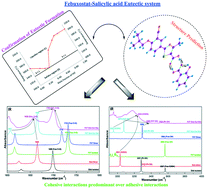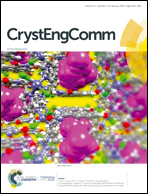A novel approach to design febuxostat-salicylic acid eutectic system: evaluation and characterization†
Abstract
The current study was aimed at investigating the febuxostat-salicylic acid (FXT-SAA) eutectic system using two polymorphs of FXT, form Q and form A. FXT, a BCS class II drug and SAA, the water-soluble co-former, were used to formulate the FXT-SAA eutectic system. The formed system was further confirmed using a binary phase diagram and powder X-ray diffraction (PXRD) analysis. Differential scanning calorimetry (DSC) depicted the formation of the FXT-SAA eutectic system, as indicated by the depression of the melting point (observed at 132 °C) compared with the melting points of the individual components, i.e., FXT (208 °C for form A and 206 °C for Form Q) and SAA (160 °C). Raman and Infrared spectroscopy (IR) were used to confirm the intermolecular interactions between FXT and SAA with both forms of FXT. A novel approach was used to investigate the probable hydrogen bonding interactions in the FXT : SAA (1 : 1) eutectic system of FXT form Q. Dimers formed between the same molecules represented cohesive interactions, whereas those formed between different molecules represented adhesive interactions. The vibrational modes of dimers of FXT and SAA are closer to the experimental eutectic system than the modes of the simulated eutectic system (FXT-SAA), suggesting that the interactions in the eutectic system are predominantly cohesive. The results are in accordance with the reported theory for eutectic systems. The approach was found to be an add-on for existing methods to confirm eutectic formation in the given system. Additionally, the molecular electrostatic potential (MEP) surface predicted the negative and positive potential sites that participate in the inter-molecular hydrogen bonding.



 Please wait while we load your content...
Please wait while we load your content...